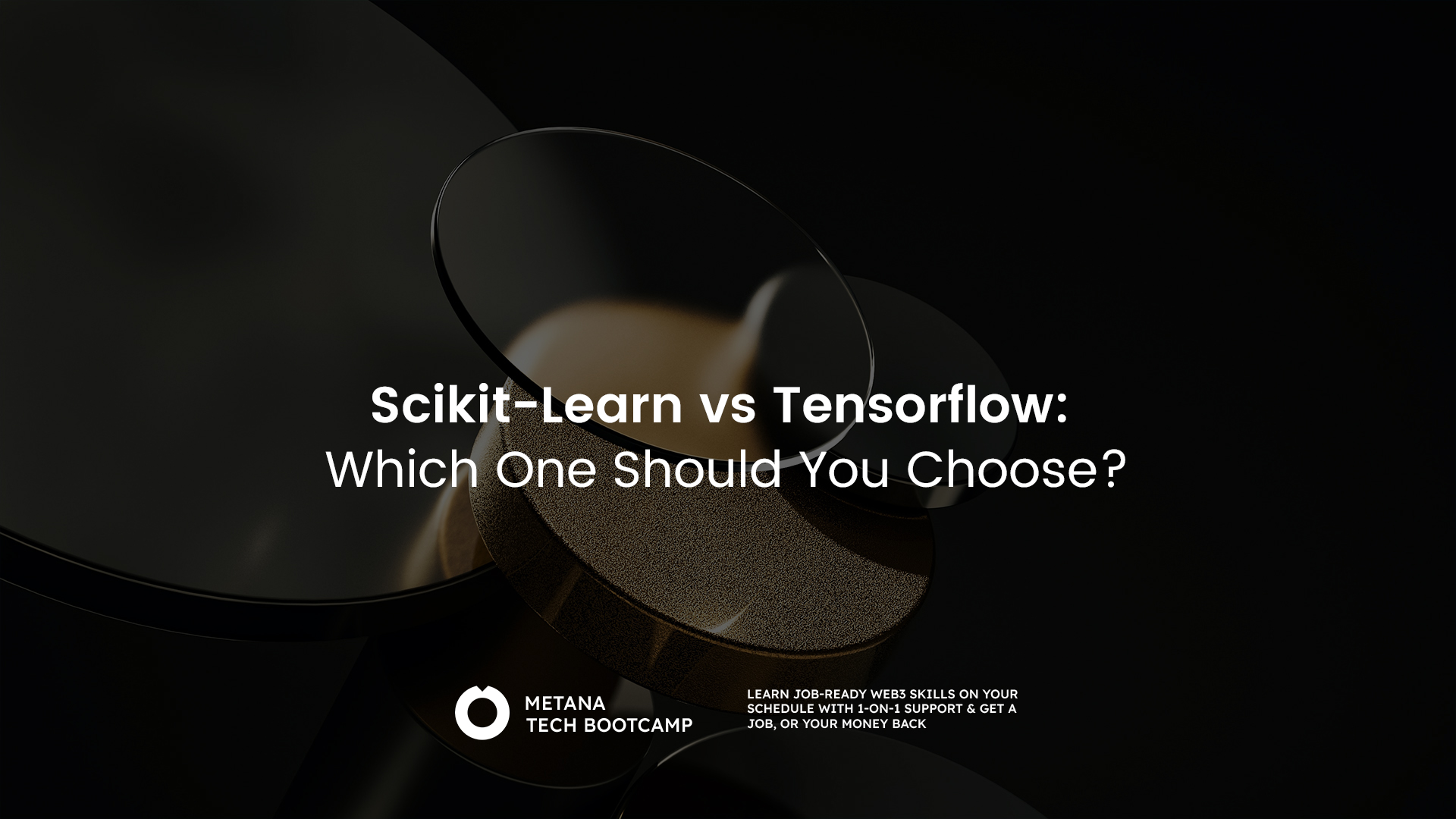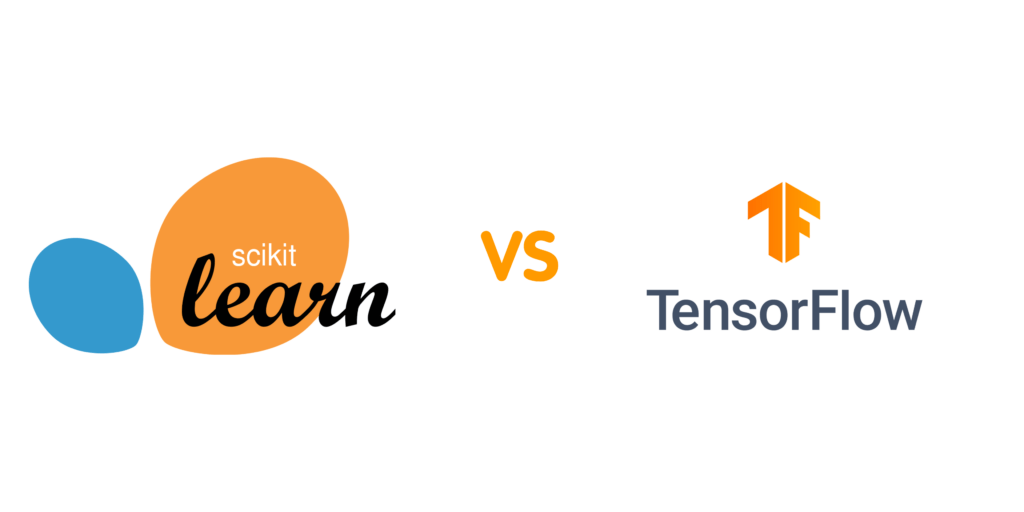Scikit-Learn vs Tensorflow : Which One Should You Choose?
 Metana Editorial
Metana Editorial
Ready for a face-off between two awesome machine learning tools? Let’s meet our players! In one corner, we have Scikit-learn, a super user-friendly tool that’s loved for how simple and versatile it is. And in the other corner, we have TensorFlow, a deep learning champ that’s known for its powerful and advanced features. Buckle up because we’re about to explore Scikit-learn vs TensorFlow in the exciting world of machine learning. Get ready for a thrilling showdown that will show you just how amazing these tools are!
Scikit-learn and TensorFlow are both really powerful tools that we use for machine learning. Scikit-learn is loved for being easy to use, while TensorFlow is a star when it comes to deep learning. Both have lots of useful features and are widely used in the field. They’ve helped to totally change the way we use data to make smart choices.

What is Scikit-Learn?
Scikit-learn is a tool we use for machine learning in Python. It’s really helpful and easy to use. It has lots of different tools and ways to do things, which makes it great for many types of machine learning jobs. These can be things like sorting data into groups, predicting things, or reducing dimensions. Scikit-learn can do all of this and more!
One of the big reasons why Scikit-learn is good is because it’s easy to use and simple. This makes it perfect for people who are just starting to learn about machine learning. It also has lots of helpful guides and a group of users who can offer support and resources.
While Scikit-learn is pretty great, it does have some things that it’s not so good at. It’s mostly designed for traditional machine learning, so it doesn’t support more advanced stuff like deep learning models and complex neural networks as much. If you need to do those things, you might want to use something like TensorFlow. Also, if you’re working with a really big amount of data, Scikit-learn might not be the best choice.
Here’s a table that summarizes the strengths and weaknesses of Scikit-Learn,
| STRENGTHS | LIMITATIONS |
| Ease of use and simplicity | Limited support for deep learning models and complex neural networks |
| Vast collection of well-documented resources and community support | Performance limitations when dealing with large-scale datasets and tasks |
| Consistent API and extensive documentation |
In the next section, we’ll plunge into the world of TensorFlow, exploring how it compares to Scikit-learn and what sets it apart in the realm of deep learning.
What is TensorFlow?
TensorFlow is a tool that we use for machine learning. It’s open-source, which means anyone can use it for free! Google made TensorFlow, and it’s really powerful. It’s great for creating advanced machine learning models and deep neural networks. Plus, it’s flexible and can handle lots of different tasks.
TensorFlow is awesome because it’s really flexible. It’s especially good for deep learning. Plus, it can help you work with lots of different devices or machines at the same time. This makes it great for big tasks. Also, you can use TensorFlow in different programming languages like Python, C++, and JavaScript.
While TensorFlow is really powerful, it can be a bit tricky to learn, especially if you’re a beginner. This is because it has lots of advanced features. Also, if you’re trying to put together or fix a TensorFlow model, it can be really complicated. So, TensorFlow might be a bit hard for newcomers or those who don’t know a lot about deep learning.
Here’s a table that summarizes the strengths and weaknesses of TensorFlow,
| STRENGTHS | LIMITATIONS |
| Flexibility and scalability for building complex neural networks | Steeper learning curve compared to other libraries, requiring a deeper understanding of concepts |
| Extensive support for deep learning models | Potential challenges in implementing and debugging TensorFlow models |
| Availability in multiple programming languages | |
| Support for distributed computing |
In the subsequent section, we will delve into a comparative analysis of Scikit-learn and TensorFlow, examining their key differences and use cases.
Is Scikit Better Than TensorFlow?
| COMPARISON-POINT | SCIKIT-LEARN | TENSORFLOW |
| Main Use | Traditional machine learning tasks | Deep learning tasks |
| User-friendliness | Known for simplicity and ease of use | Has a steeper learning curve due to advanced features |
| Documentation | Extensive documentation and a vibrant community | Extensive documentation, but requires deeper understanding of concepts |
| Scalability | Efficient for small to medium-sized datasets | Excels in handling big data and complex computations |
| Customization | Limited support for model customization | Offers extensive customization options |
| Neural Network Support | Limited support for complex neural networks | Provides a flexible framework for building complex neural networks |
| Distributed Computing | Doesn’t inherently support distributed computing | Supports distributed computing, allowing usage of multiple devices |
| Learning Path | Ideal for beginners or those wanting quick implementation | Better suited for individuals with prior experience or a deeper understanding of machine learning |
| Language Support | Primarily supported in Python | Available in multiple languages including Python, C++, and JavaScript |
| Focus | Focus on traditional machine learning algorithms | Focus on deep learning and neural networks |
Choosing the Right Tool for the Job: Scikit-Learn vs Tensorflow
In conclusion, Scikit-learn and TensorFlow are both valuable tools in the machine learning landscape, each with its own unique strengths. Scikit-learn’s simplicity and ease of use make it an excellent choice for traditional machine learning tasks and quick prototyping. On the other hand, TensorFlow’s capabilities in deep learning and model customization make it the go-to library for complex neural networks and large-scale projects.
Finally, the answer for the question “Is Scikit better than TensorFlow?” depends on your specific use case and requirements. If you’re starting with machine learning or need to quickly implement traditional algorithms, Scikit-learn is a solid choice. However, if you’re diving into deep learning or require extensive customization, TensorFlow is the library to explore. Understanding the strengths of both libraries in the Scikit-learn vs TensorFlow battle will help you make the right decision for your projects.
Should I Learn TensorFlow or SkLearn?
When deciding between learning TensorFlow or Scikit-learn, several factors should be taken into consideration. Here are some points to help guide your decision:
Personal Goals: Consider your personal goals and aspirations in the field of machine learning. If you have a keen interest in deep learning and complex neural networks, TensorFlow might be the better option. On the other hand, if you are more interested in traditional machine learning algorithms and want to quickly implement models, Scikit-learn can be a great choice.
Project Requirements: Evaluate the specific requirements of your projects. If your project involves deep learning tasks, such as image recognition or natural language processing, TensorFlow’s deep learning capabilities will be valuable. However, if your project revolves around traditional machine learning tasks like classification or regression, Scikit-learn’s extensive range of algorithms can be highly beneficial.
Prior Experience in Machine Learning: Take into account your level of experience in machine learning. If you are a beginner or have limited experience, Scikit-learn’s simplicity and user-friendly interface make it an excellent starting point. TensorFlow, with its more complex concepts and advanced features, might be better suited for individuals with prior experience or a solid understanding of machine learning principles.
Combination Approach: Consider leveraging the strengths of both libraries by learning both TensorFlow and Scikit-learn. While they excel in different areas, the knowledge of both frameworks can broaden your skillset and enable you to tackle a wider range of machine learning projects. Understanding the use cases where one library is more suitable than the other will allow you to choose the right tool for each specific task.
In conclusion, when you ask the question “Should I learn TensorFlow or SkLearn?”, it ultimately depends on your individual goals, project requirements, and prior experience. By assessing these factors, you can make an informed decision and determine which library aligns best with your needs in the Scikit-learn vs TensorFlow conflict. It is worth noting that being proficient in multiple machine learning libraries can provide advantages in the dynamically evolving field of machine learning.
Conclusion
The choice between Scikit-learn and TensorFlow, when it comes to machine learning, depends on individual needs and project requirements. Scikit-learn provides simplicity and a wide range of traditional algorithms, while TensorFlow excels in deep learning and model customization. Evaluating specific use cases is essential to make an informed decision. Continuous exploration and learning from both libraries enhance expertise in Scikit-learn vs TensorFlow, empowering practitioners to leverage their unique strengths and achieve success in the ever-evolving field of machine learning.
Subscribe to my newsletter
Read articles from Metana Editorial directly inside your inbox. Subscribe to the newsletter, and don't miss out.
Written by
